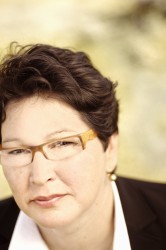Article Origin
Volume
Issue
Year
“The difficult was easy, the impossible took a little longer,” said Father Paul Hefferenan in his 1995 eulogy to Canada’s First Female Indian Act Chief, Elsie Marie Knott of the Curve Lake First Nation in southeastern Ontario. Chief Knott, elected in 1952, who served for eight years in this pioneering role, is the touchstone of Cora Voyageur’s groundbreaking study of First Nations Women Chiefs, Firekeepers of the Twenty-First Century.
Voyageur, from the Athabasca Chipewyan First Nation, is professor of sociology at the University of Calgary and also leads the Indigenous Women in Leadership program at the Banff Centre. In this first academic study of women chiefs in Canada published in 2008, Voyageur interviewed 64 of 90 women chiefs to understand their experiences.
“Nobody really knows what a Chief does,” said Voyageur, describing the role as “a combination of CEO and mayor.” That many families on the reserves are related or know one another personally presents an additional complexity.
In the study she was surprised to discover that three-quarters of the women were from political families.
“They also learned about politics at an early age and became accustomed to the political realm of reserve politics,” she writes. “Many believed that they had been groomed, however unknowingly, for their present positions.”
Voyageur also discovered that most had strong educational backgrounds.
It was not surprising to learn that women chiefs face the same obstacles as all working women. Voyageur writes, “They deal with household chores, children, spouse, and the never-ending struggle to maintain a balance between work and the rest of life.” Unlike other working women, however, “as Chiefs they are also expected to be jacks of all trades and experts in many different areas.” These include a host of different issues including fisheries, mining, resource development and social issues.
Of greater consequence, women chiefs must not only deal with racism and discrimination, but also sexism.
“Some believe that women are incapable of making hard decisions and base their deliberation on emotion rather than logic,” Voyageur writes.
“The most effective women have formal education, know issues, and are effective, caring and honest leaders,” she said. She also found that women leaders are more willing to do tedious work.
Voyageur concludes that women chiefs face many professional and personal concerns. “These professional concerns include trying to improve living conditions on the reserve through increased employment, educational attainment, better housing, and expanded infrastructure. On the personal side, women chiefs must overcome sexism, racism, and self-doubt, maintain a balance between work and life, sustain family relations and friendships and try to find time to care for themselves.”
While conducting her study, Voyageur was asked continuously about the difference between men and women.
“Is the experience of male chiefs different than women chiefs?” She has begun to explore this question in a recently launched follow-up gender-based study that will survey the experiences of all 600 plus Canadian chiefs.
Along the way, she hopes to continue to dispel some of the deeply held myths and stereotypes that characterize leadership in Aboriginal communities, particularly the view of corruption the media often latches onto.
“There are bad apples everywhere,” she said.0
- 1877 views

